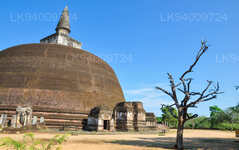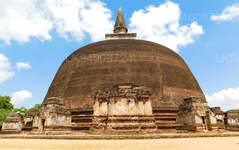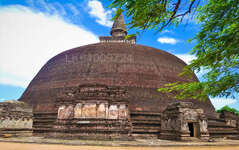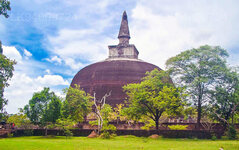
Polonnaruwa City
Polonnaruwa, a UNESCO World Heritage Site in Sri Lanka, was the country's medieval capital (11th-13th century). Renowned for its well-preserved ruins, including the iconic Gal Vihara statues, it showcases impressive architecture, reflecting the grandeur of the ancient Sinhalese civilization.
Rankoth Vehera
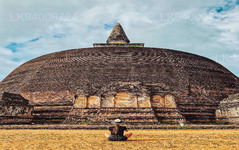

Rankoth Vehera in Sri Lanka: Stupa with the Golden Pinnacle
Polonnaruwa was the second kingdom of the ancient kings of Sri Lanka, after the kingdom of Anuradhapura. Following the older tradition of the kings of the first kingdom, the Polonnaruwa kings too saw fit to leave their footprints in the form of stupas built during their times of reign. The stupas were usually different from in design from those of the Anuradhapura kings and followed a style unique to Polonnaruwa, but there were a few exceptions.Rankoth Vehera in Sri Lanka: Resembling Ruwanwelisaya
Ruwanweli is a stupa built by the king Nissanka Malla who ruled Polonnaruwa (AD 1187 – 1196). It was constructed in the style of the original Anuradhaphura Maha Vihara monastery stupas, bearing a close resemblance to one of the most famous stupas of Sri Lanka – ‘Ruwanwelisaya’. The original name of the stupa indicates that perhaps this resemblance was intentional. However the name was changed later on to ‘Rankoth Vehera’. ‘Ran’ means gold, and ‘koth’ is the word used for the pinnacle of a stupa in the Sinhalese language. Hence Rankoth Vehera approximates in English to ‘Stupa with the Golden pinnacle’. Rankoth Vehera is one of the most well-known and revered stupas of the Polonnaruwa era.
Rankoth Vehera in Sri Lanka: 10 Things You Should know about Rankoth Vehera
- Brick was the only construction material used in the entire stupa.
- Rankoth Vehera’s circular base has a diameter of approximately 170m (550 feet) and a height of approximately 33m (108 feet) at the tip of the stupa.
- However, renovation was carried out on the upper portion of Rankoth Vehera by later rulers changing the height of the structure. Research has shown that the original height of the stupa may have been as great as 200 feet (61m).
- Even after the drastic decrease Rankoth Vehera remains the largest stupa in Polonnaruwa, and the fourth largest in the country.
- Rankoth Vehera has four Vahalkadas supporting the weight of the stupa, which are also made of brick.
- The entire stupa lies in the center of a large square terrace that is surrounded by a brick wall.
- The terrace has four entrances in the directions of the four cardinal points, with sand paths leading up to them.
- It is inscribed on a stone close to one of the entrance that King Nissanka Malla watched over and supervised the construction of the stupa.
- The inscription also mentions that he worshiped the stupa from a stone platform.
- This platform can be found at a corner of the terrace on which the stupa is placed.
Polonnaruwa, along with Anuradhapura, has a literal treasure trove of well-preserved historical places to visit, such as Rankoth Vehera.
About Polonnaruwa District
Polonnaruwa is the 2nd largest city in north central province in Sri Lanka. The ancient city of Polonnaruwa has been declared a World Heritage site by UNESCO Polonnaruwa has a great history of conquest and struggle behind it and rightfully forms the third element in the Cultural Triangle. Located about 140 kms north east from Kandy,Polonnaruwa offers hours of endless pleasure for history and culture lovers, as there are numerous sights of significance.
Much of the physical ruins standing today are credited to King Parakrama Bahu I who spent many royal resources on town planning, including parks, edifices, irrigation systems and so on. The period of his rule is considered a golden age where the kingdom thrived and prospered under a visionary ruler. The Parakrama Samudra is a mammoth tank and named after its patron. The popular kings Royal Palace, the Audience Hall encircled by beautifully carved stone elephants and the Bathing Pool reflect the superior engineering capabilities of the time.
About North Central Province
North Central Province which is the largest province in the country covered 16% of total country's land area. North Central Province consist two districts called Polonnaruwa and Anuradhapure. Anuradhapura is the largest district in Sri Lanka. Its area is 7,128 km².
North Central Province has numerous potentials for Investors to start their Businesses, especially Agriculture, agro based industries and Livestock sectors. More than 65% of North Central Province's people depend on basic Agriculture and agro base industries. NCP also called "Wew Bendi Rajje" because there are more than 3,000 medium and large scale tanks situated in the province. Sri maha bodiya, Ruwanweli seya, Thuparama dageba, Abayagiri Monastry, Polonnaruwa Rankot wehera, Lankathilake are scared

